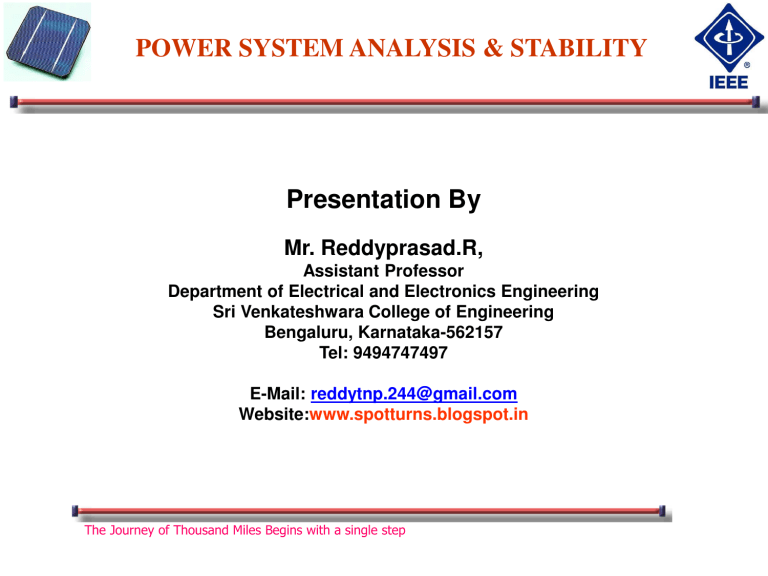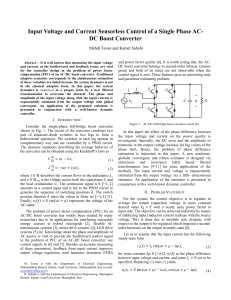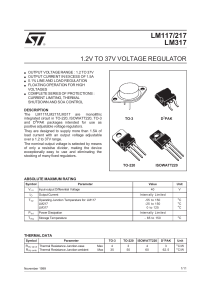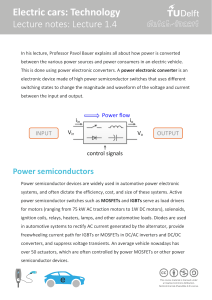
POWER SYSTEM ANALYSIS & STABILITY Presentation By Mr. Reddyprasad.R, Assistant Professor Department of Electrical and Electronics Engineering Sri Venkateshwara College of Engineering Bengaluru, Karnataka-562157 Tel: 9494747497 E-Mail: [email protected] Website:www.spotturns.blogspot.in The Journey of Thousand Miles Begins with a single step What is Power System Stability? • The Ability of the system to maintain stable operation after the disturbances. Why we go for Power System Stability Analysis? Transmission � Maximum power Transfer Reliability Make it Economical Energy Scenario • Globally 70% total energy comes from burning of fossil fuels like gas, coal, oil. • 6% comes from Nuclear, 7% Renewables. • In our country 70% energy form Coal plants. (1955) Projection of IEEE Journal (2015) Natural Uranium – 50 Years Oil – 100 Years AT NOW SAME Natural gas – 150 Years Journal Coal – 200 Years This Projection made Exactly 60 Years back Now my Question is Energy Conservation Answer: Will the Wheels of Civilization comes to a halt at the end of 20th Century? Objectives: What is Energy conservation? • Utilize electrical energy efficiently and economically • Reduce the Fossil fuel consumption • Explore the newer places to generate fuels. Thermal Power plant In India major Power Comes from Thermal Power plants (70%) Losses Associated in Thermal Power Generation Chemical Energy Input (100 BTU (94 BTU) Boiler ) Reduction of 6 Unit Thermal Energy (88 BTU Turbine ) Mech. Energy (36 BTU Generator ) i.e 1 Unit at load end=6 units at generating end Efficiency = 29% Elec. Energy Output (10.26 (16.66 Wh BTU) ) (15.66 Reduction of 1 Unit (with out MHD) Efficiency = 35% (with MHD) How to Save by using power electronics Transmission Efficiency � Utilization Efficiency � Maximum power Transfer Stability Distribution Efficiency � Renewables Generation � POWER SYSTEM COMPONENTS Generation Primary Transmission(132/220/400/765KV) Dhuvaran Karamsad CB Power Plant X’ er Sending end SS(11/220kV) Commercial/ Industrial Customer CB Bus-bar 220 kV Steel Tower Primary Grid (220/66 kV) Bus-bar 66 kV Transmission GCET Secondary Transmission(66/132KV) Distribution Transformer (11/0.415 kV) Urban Customers Primary Distribution V V Nagar Secondary Grid Secondary Distribution (66/11 kV) Distribution Pole Underground Cable To Other Residential Customer Residential Customer 66Kv Substations An Analogy – Power System vs Human Body RLDC::Brain Generation :: Heart USER Sub-Transmission :: Sub-Arteries Transmission :: Main Arteries Distribution :: Capillaries The Generation… Human Body Power System Blood Pressure Voltage Heart Beat Frequency The Pulse 72 Beats/Minutes 50 Cycles/Seconds Cause Stress/Anxiety Load-Gen.-Mismatch Risk Heart Beat Deviation Frequency Deviation What is Power System Stability? Power system must maintain certain conditions to maintain stable operation Voltage Variations- +6% to -6% Frequency Variations- +5% to -5% i.e (48.5-52.5) Hz Now it is tightened to Reduce The stability failures At 2001 year Voltage Variations- +5% to -5% Frequency Variations- +2% to -2% i.e (49.9-50.1) Hz What causes makes Power System unstable? What Happened if Power System Losses Stability? BLACK OUT (UN EXPECTED OUTAGES) millions of article location people affected date 620 India 30 July 2012-31 July 2012 230 India 2 January 2001 150 Bangladesh 1 November 2014 2015 Pakistan blackout 140 Pakistan 26 January 2015 2005 Java–Bali blackout 100 Indonesia 18 Aug 2005 1999 Southern Brazil blackout 97 Brazil 11 March 1999 2009 Brazil and Paraguay blackout 87 Brazil, Paraguay 10–11 Nov 2009 2015 Turkey blackout 70 Turkey 31 March 2015 Northeast blackout of 2003 55 United States, Canada 14–15 Aug 2003 2003 Italy blackout 55 Italy, Switzerland, Austria, Slovenia, Croatia 28 Sep 2003 Thailand Nationwide blackout of 1978 40 Thailand 18 Mar 1978 Northeast blackout of 1965 30 United States, Canada 9 Nov 1965 July 2012 India blackout(24-28 hours) January 2001 India blackout(12 hours) November 2014 Bangladesh blackout LOCATION MAP of Blackout at the year 2012 22 STATES (24-28 Hours) LOCATION MAP Affected 2 days by the power outages (on 30 and 31 July) Affected 1 day by the power outages (on 31 July) Main Reasons for Grid Failure At 02:35 IST (21:05 UTC on 29 July 2012), circuit breakers on the 400 kV Bina-Gwalior line tripped. As this line fed into the Agra-Bareilly transmission section, breakers at the station also tripped, and power failures cascaded through the grid. All major power stations were shut down in the affected states, causing an estimated shortage of 32 GW. Offi ials des ri ed the failure as "the worst i a de ade“ Spokesperson for PowerGrid Corporation of India Limited (PGCIL) and the Northern Regional Load Dispatch Centre (NRLDC) stated that Uttar Pradesh, Punjab and Haryana were the states responsible for the overdraw. EFFECTS ???? BLACKOUT (northern grid failure) Huge Traffic Jam in Delhi Peoples strucked inElectrical Trains RESULTS NO POWER IN ALL METROPOLITAN CITIES OF NORTH INDIA Power System Instability not only effected Blackout and also effects o E uip e t Da ages which is used i powe syste s…………….. Transmission Line dead at Austria 500KV line Opened under load Substation transformer failure 9 ELECTRIC FAIL, EXPLOSION, HIGH VOLTAGE, FIRE. 2007 CWLP Dallman Accident Substation Failure Due to instability What causes makes Power System unstable? Sudde trippi g of CB’s are Tur i g off huge Loads at load e d Sudden breakdown of Generating units or Sudden increment of Load demands. Capacitors banks under no load Short circuit faults like LG,LLG,LLL,LLLG. Switching surges because of Lightning's Fault Trippi g of CB’s Transmission lines overloaded beyond surge impedance loading How to Overcome or Increase Stability? Answer: By increasing Maximum power Transferring capability of Transmission Lines Power Transferring Capability of Transmission Lines Limits Affecting Max. Power Transfer Thermal limits – limit is due to heating of conductor and hence depends heavily on ambient conditions. – For many lines, sagging is the limiting constraint. – Newer conductors/materials limit can limit sag. – Trees grow, and will eventually hit lines if they are planted under the line, – Note that thermal limit is different to the steady-state stability limit that we just calculated: – Thermal limits due to losses, – Steady-state stability limit applies even for lossless line! 24 Tree Trimming: Before 25 Tree Trimming: After 26 Other Limits Affecting Power Transfer Angle limits – while the maximum power transfer (steady-state stability limit) occurs when the line angle difference is 90 degrees, actual limit is substantially less due to interaction of multiple lines in the system Voltage stability limits – as power transfers increases, reactive losses increase as I2X. As reactive power increases the voltage falls, resulting in a potentially cascading voltage collapse. 27 Power factor correction capacitors for A, B, and C phases at the Crofton , MD substation Rating: 230 kV, 360 MVAR size comparison Capacitor banks Shunt Capacitor Compensation �� Requirement • If Reactive Load Increases receiving end Voltage falls down • We need to develop more Reactive power (�� )with capacitors to compensate Actual Going on �22 �� = �� � = � − �� ∗ � Un Reliable Friend � FACTS Solutions FACTS: Flexible AC Transmission Systems •Greater demands are being placed on the transmission network and will continue. At the same time, it is becoming more difficult to acquire new rights of way for new transmission infrastructure and lines. •FACTS create new opportunities in controlling power, enhancing the usable capacity of present and future transmission; improving system performance, reliability and security; and validating the use of power electronics to enhance power systems operation and dynamic performance. •Up to 40% additional capacity of existing grid infrastructure can be realized in some locations through strategic FACTS implementation FACTS Solutions Shunt and Series Connected Configurations DC Voltage Source Converter Converter Transformer Power System STATCOM Ed TCSC How Power electronics converters improves Power system stability? Medium Voltage DC Network Concept Existing AC Infrastructure Future HVDC Intertie Fuel Cells AC Transmission Supply FACTS Compensation Non -Synchronous Generation (Wind) STATCOM / SVC DC DC DC DC HVDC System Photovoltaic Generation AC DC DC DC AC DC HVDC / MVDC DC DC DC DC DC DC DC DC Distribution DC Load Circuits DC DC DC AC DC AC Electric Vehicle Future DC Industrial Facility Future DC Data Centers DC AC Motor Distribution Level Storage Variable Frequency Drives Control Algorithm Sensitive Load Electronic and AC Loads Application Areas Power Systems • HVDC • Flexible AC Transmission System (FACTS) • CUSTOM Power Devices • Distributed Generation • FRIENDS (Flexible, Reliable and Intelligent Electrical Energy Delivery System) Contd….. HVDC Solutions HVDC: High Voltage DC Transmission Systems: • More power can be transmitted more efficiently over long distances by applying HVDC, and is less costly for underground installation • HVDC lines can carry 2 to 5 times the capacity of an AC line of similar voltage, over the same right of way • Interconnection of two AC systems, where AC lines would not be possible due to stability problems or both systems having different nominal frequencies • HVDC transmission is necessary for underwater power transfer if the cables are longer than 50km • Power flow can be controlled rapidly and accurately • Higher reliability and greater resiliency to disturbances • Offers a solution to a ‘national strategy’ for grid modernization HVDC Solutions DC Transmission and Back-to-Back Link Configurations CONVERTER STATION THYRISTOR VALVE HALL DC Transmission Lines AC Network (A) ~ or ~ AC Network (B) BtB DC-Link Converter Station A Converter Station B THANK YOU New Age War of the Currents: AC vs DC Equivalent Circuit_of Synchronous generator motor Ia jXl jX Ra + + generator + Ef Eres Ia Vt Equivalent circuit of a cylindrical-rotor synchronous machine Phasor Diagram Phasor diagram of a cylindrical-rotor synchronous generator, for the case of lagging power factor Lagging PF: |Vt|<|Ef| for overexcited condition Leading PF: |Vt|>|Ef| for underexcited condition






